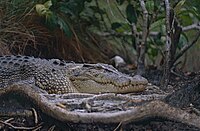Template:Did you know/Saltwater crocodile: Difference between revisions
mNo edit summary Tag: Manual revert |
mNo edit summary |
||
| Line 1: | Line 1: | ||
[[Saltwater crocodile (Crocodylus porosus)]] | [['''Saltwater crocodile (Crocodylus porosus)''']] | ||
[[File:Saltwater Crocodile (Crocodylus porosus) (9730765533).jpg|200x200px|frameless|right|alt=Saltwater Crocodile (Crocodylus porosus)|Saltwater Crocodile (Crocodylus porosus)]] | [[File:Saltwater Crocodile (Crocodylus porosus) (9730765533).jpg|200x200px|frameless|right|alt=Saltwater Crocodile (Crocodylus porosus)|Saltwater Crocodile (Crocodylus porosus)]] | ||
* It is the largest living reptile, reaching over 6 meters in length and weighing over 1,000 kg. | * It is the largest living reptile, reaching over 6 meters in length and weighing over 1,000 kg. | ||
Revision as of 19:10, 12 January 2024
'''Saltwater crocodile (Crocodylus porosus)'''

- It is the largest living reptile, reaching over 6 meters in length and weighing over 1,000 kg.
- It inhabits both saltwater and freshwater habitats across India, Southeast Asia, and northern Australia.
- It has the highest bite force of any animal, with a pressure of 2.5 tons per square inch.
- It is an opportunistic predator that can eat almost any animal, including mammals, reptiles, birds, fish, and even sharks and other crocodiles.
- It can swim at speeds of 15 miles per hour, holding its limbs against its body to become more streamlined.
